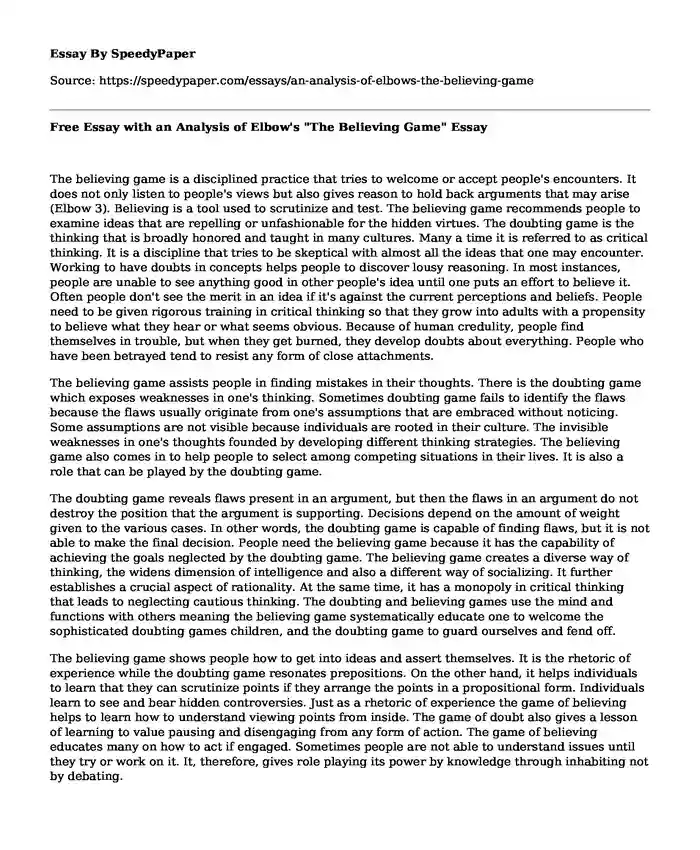
| Type of paper: | Essay |
| Categories: | Literature Motivation |
| Pages: | 4 |
| Wordcount: | 840 words |
The believing game is a disciplined practice that tries to welcome or accept people's encounters. It does not only listen to people's views but also gives reason to hold back arguments that may arise (Elbow 3). Believing is a tool used to scrutinize and test. The believing game recommends people to examine ideas that are repelling or unfashionable for the hidden virtues. The doubting game is the thinking that is broadly honored and taught in many cultures. Many a time it is referred to as critical thinking. It is a discipline that tries to be skeptical with almost all the ideas that one may encounter. Working to have doubts in concepts helps people to discover lousy reasoning. In most instances, people are unable to see anything good in other people's idea until one puts an effort to believe it. Often people don't see the merit in an idea if it's against the current perceptions and beliefs. People need to be given rigorous training in critical thinking so that they grow into adults with a propensity to believe what they hear or what seems obvious. Because of human credulity, people find themselves in trouble, but when they get burned, they develop doubts about everything. People who have been betrayed tend to resist any form of close attachments.
The believing game assists people in finding mistakes in their thoughts. There is the doubting game which exposes weaknesses in one's thinking. Sometimes doubting game fails to identify the flaws because the flaws usually originate from one's assumptions that are embraced without noticing. Some assumptions are not visible because individuals are rooted in their culture. The invisible weaknesses in one's thoughts founded by developing different thinking strategies. The believing game also comes in to help people to select among competing situations in their lives. It is also a role that can be played by the doubting game.
The doubting game reveals flaws present in an argument, but then the flaws in an argument do not destroy the position that the argument is supporting. Decisions depend on the amount of weight given to the various cases. In other words, the doubting game is capable of finding flaws, but it is not able to make the final decision. People need the believing game because it has the capability of achieving the goals neglected by the doubting game. The believing game creates a diverse way of thinking, the widens dimension of intelligence and also a different way of socializing. It further establishes a crucial aspect of rationality. At the same time, it has a monopoly in critical thinking that leads to neglecting cautious thinking. The doubting and believing games use the mind and functions with others meaning the believing game systematically educate one to welcome the sophisticated doubting games children, and the doubting game to guard ourselves and fend off.
The believing game shows people how to get into ideas and assert themselves. It is the rhetoric of experience while the doubting game resonates prepositions. On the other hand, it helps individuals to learn that they can scrutinize points if they arrange the points in a propositional form. Individuals learn to see and bear hidden controversies. Just as a rhetoric of experience the game of believing helps to learn how to understand viewing points from inside. The game of doubt also gives a lesson of learning to value pausing and disengaging from any form of action. The game of believing educates many on how to act if engaged. Sometimes people are not able to understand issues until they try or work on it. It, therefore, gives role playing its power by knowledge through inhabiting not by debating.
Conclusion
The game of believing is alive, but then again it is not well founded in people's midst. If one has a closer view of the people who appear smart and intensely creative, people who many a time come up with new ideas and solutions that are creative, people who can have positive collaborations with others that bring actions. Often, one observes that most of those people are applying the believing game. In most cases, one is not able to see anything good in other people's idea until they put effort into believing it. Individuals' need the believing game because it has the capability of achieving the goals neglected by the doubting game. The believing game creates a diverse way of thinking, the dimension of intelligence and also different way of socializing. The doubting game creates a crucial dimension of rationality. Decisions depend on the amount of weight given to the various arguments. In other words, the doubting game is capable of finding flaws, but it is not able to make the final decision. Sometimes doubting game fails to identify the flaws because the flaws usually originate from people's assumptions that they embrace without noticing. Some assumptions are not visible because individuals are rooted in their cultural and traditional backgrounds.
Works Cited
Elbow, Peter. "The Believing Game or Methodological Believing." The Journal of the Assembly for Expanded Perspectives on Learning 14.1 (2008): 3.
Cite this page
Free Essay with an Analysis of Elbow's "The Believing Game". (2022, Apr 20). Retrieved from https://speedypaper.com/essays/an-analysis-of-elbows-the-believing-game
Request Removal
If you are the original author of this essay and no longer wish to have it published on the SpeedyPaper website, please click below to request its removal:
- Free Essay on Digital Marketing Proposal Sample
- Religion Essay Example: Reason and Rationale for the Canonical Scriptures
- Free Essay on Healthcare Start-up Budget: Heart Treatment Services to Women
- Free Essay on Laboratory Information Management Systems
- Comparison Essay Sample: Etiquette and Behavior in Public in the US and Ecuador
- Clarity of the Presentation of the Results
- Paper Example - Gaps and Silences From the Novel Parvana by Deborah Ellis
Popular categories




